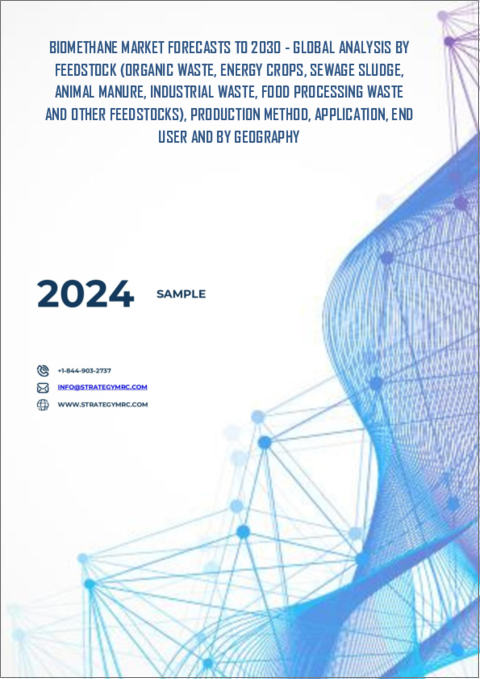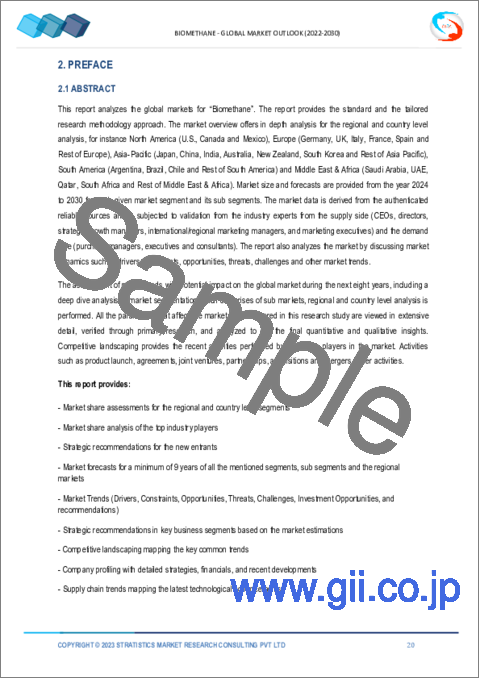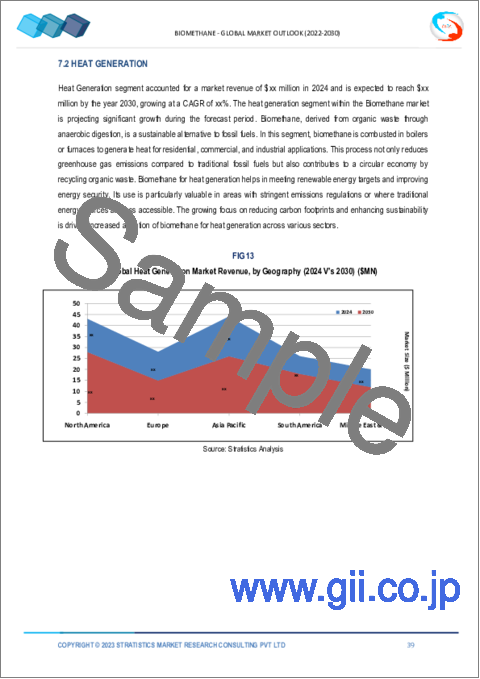|
|
市場調査レポート
商品コード
1494791
バイオメタン市場の2030年までの予測:原料、製造方法、用途、エンドユーザー、地域別の世界分析Biomethane Market Forecasts to 2030 - Global Analysis By Feedstock (Organic Waste, Energy Crops, Sewage Sludge, Animal Manure, Industrial Waste, Food Processing Waste and Other Feedstocks), Production Method, Application, End User and By Geography |
||||||
カスタマイズ可能
|
|||||||
| バイオメタン市場の2030年までの予測:原料、製造方法、用途、エンドユーザー、地域別の世界分析 |
|
出版日: 2024年06月06日
発行: Stratistics Market Research Consulting
ページ情報: 英文 200+ Pages
納期: 2~3営業日
|
全表示
- 概要
- 図表
- 目次
Stratistics MRCによると、バイオメタンの世界市場は2024年に42億8,000万米ドルを占め、予測期間中のCAGRは10.8%で成長し、2030年には63億2,000万米ドルに達する見込みです。
バイオメタンは再生可能天然ガス(RNG)としても知られ、化石燃料由来の従来の天然ガスに代わる持続可能な代替物です。バイオメタンは化学的に天然ガスと同じであり、暖房、発電、輸送のために既存のガスインフラで互換的に使用することができ、再生可能で低炭素のエネルギー源を提供し、潜在的な環境的利益をもたらします。
世界バイオガス協会(WBA)によると、バイオガスは世界の温室効果ガス排出量を10~13%削減でき、世界の生ごみ、産業廃棄物、農業からの原料、下水から再生可能エネルギーを供給できます。
気候変動と大気汚染への懸念の高まり
化石燃料の消費が環境に与える影響に対する社会の認識が高まるにつれ、よりクリーンで再生可能なエネルギー源に対する需要が高まっています。有機廃棄物由来のバイオメタンガスは、従来の化石燃料に代わる持続可能な代替エネルギーであり、暖房、発電、輸送に使用した場合の温室効果ガス排出量や大気汚染物質を大幅に削減します。このようなクリーンなエネルギー源に対する意識の高まりと需要は、気候変動の緩和と大気環境の改善に大きく貢献するものとして、バイオメタン市場の成長を後押ししています。
断続的供給
バイオメタン生産における断続的な供給は、有機原料の利用可能性の変動性と季節性に起因します。作物の生育や廃棄物の発生率に影響を与える天候のような要因が、この予測不可能性の一因となっています。この断続性は、一貫した信頼できるバイオメタン供給を維持するための課題となり、エネルギー生産と配給の信頼性に影響を与えます。ひいては、この不確実性が潜在的な投資家を遠ざけ、市場の成長を妨げることにもなりかねないです。
持続可能な廃棄物管理ソリューションの導入
嫌気性消化やバイオガス化などの持続可能な廃棄物管理ソリューションの導入は、バイオメタン市場の成長を促進する上で極めて重要な役割を果たします。これらのソリューションは有機廃棄物を埋立地から転換し、メタン排出と環境汚染を削減します。有機廃棄物をバイオメタン製造の原料として利用することで、これらのプロセスは廃棄物処理の課題を軽減するだけでなく、貴重な再生可能エネルギー資源を生み出します。その結果、豊富で多様な原料ソースが利用可能になることで、バイオメタン生産が促進され、市場拡大が促進され、より持続可能なエネルギーの未来への移行が促進されます。
バイオメタン配給と利用のための限られたインフラ
バイオメタン配給と利用のためのインフラが限られているのは、ガス供給網の注入ポイントや燃料補給ステーションといった特殊な設備が必要なためです。このようなインフラの構築には、多額の投資と、エネルギー会社、政府機関、輸送業者などの利害関係者間の調整が必要です。このようなインフラの不足は、エネルギー源としてのバイオメタンへのアクセスや拡張性を制約し、市場の成長を妨げます。
COVID-19の影響
COVID-19の大流行は当初、サプライチェーンの混乱、プロジェクトの遅延、経済の不確実性に起因する投資の減少により、バイオメタン市場の成長を鈍化させました。しかし、世界が景気回復と持続可能な解決策に注目する中、バイオメタンを含む再生可能エネルギー源への関心が再び高まっています。政府の景気刺激策やグリーン復興イニシアティブは、バイオメタン・インフラや生産施設への投資を奨励することで、市場の成長を加速させる可能性があります。
予測期間中、有機廃棄物分野が最大になる見込み
有機廃棄物セグメントは有利な成長を遂げると推定されます。生ごみ、農業残渣、糞尿などの有機廃棄物は、バイオメタン生産の貴重な原料として役立ちます。嫌気性消化によって微生物が廃棄物を分解し、主にメタンから成るバイオガスを生産します。このバイオガスを精製することで、天然ガスに匹敵する再生可能エネルギーであるバイオメタンを生産することができます。有機廃棄物をバイオメタンに利用することは、環境汚染を軽減するだけでなく、持続可能なエネルギー生産と廃棄物管理にも貢献します。
予測期間中にCAGRが最も高くなると予想されるのは発電分野です。
予測期間中、CAGRが最も高くなると予想されるのは発電分野です。バイオメタンは、持続可能な燃料源として発電に重要な役割を果たしています。この用途では、バイオメタンをガスタービンやエンジンで燃焼させて発電機を駆動し、電力を生産します。バイオメタンの利用は、化石燃料に比べて温室効果ガスの排出を削減し、よりクリーンなエネルギー生産に貢献します。さらに、バイオメタンは既存の送電網に組み込むことができ、環境への影響を軽減しながら、増大するエネルギー需要を満たす信頼性の高い再生可能な電力源を提供することができます。
最大のシェアを占める地域
予測期間中、アジア太平洋地域が最大の市場シェアを占めると予測されます。急速な都市化、人口増加、工業化により、公害や温室効果ガス排出に対する懸念が高まり、各国政府は持続可能なエネルギーソリューションを模索するようになった。再生可能エネルギーを促進する政府の政策は、環境問題に対する意識の高まりと相まって、特に中国、インド、日本などの国々で、地域全体のバイオメタン事業の開発を促進しています。
CAGRが最も高い地域:
環境問題への関心の高まりと再生可能エネルギーへのシフトにより、予測期間中、欧州のCAGRが最も高くなると予測されます。再生可能エネルギーの導入を促進する厳しい規制が、政府の支援策と相まって、バイオメタン生産施設への投資に拍車をかけています。同市場は、特にドイツ、英国、スウェーデン、フランスといった国々でバイオメタン製造施設のネットワークが拡大していることが特徴です。
無料のカスタマイズサービス
本レポートをご購読のお客様には、以下の無料カスタマイズオプションのいずれかをご利用いただけます:
- 企業プロファイル
- 追加市場プレーヤーの包括的プロファイリング(3社まで)
- 主要企業のSWOT分析(3社まで)
- 地域セグメンテーション
- 顧客の関心に応じた主要国の市場推計・予測・CAGR(注:フィージビリティチェックによる)
- 競合ベンチマーキング
- 製品ポートフォリオ、地理的プレゼンス、戦略的提携に基づく主要企業のベンチマーキング
目次
第1章 エグゼクティブサマリー
第2章 序文
- 概要
- ステークホルダー
- 調査範囲
- 調査手法
- データマイニング
- データ分析
- データ検証
- 調査アプローチ
- 調査情報源
- 1次調査情報源
- 2次調査情報源
- 前提条件
第3章 市場動向分析
- 促進要因
- 抑制要因
- 機会
- 脅威
- 用途分析
- エンドユーザー分析
- 新興市場
- COVID-19の影響
第4章 ポーターのファイブフォース分析
- 供給企業の交渉力
- 買い手の交渉力
- 代替品の脅威
- 新規参入業者の脅威
- 競争企業間の敵対関係
第5章 世界のバイオメタン市場:原料別
- 有機性廃棄物
- エネルギー作物
- 下水汚泥
- 動物の肥料
- 産業廃棄物
- 食品加工廃棄物
- その他の原料
第6章 世界のバイオメタン市場:製造方法別
- 嫌気性消化
- ガス化
- 熱分解
- 化学的メタン化
- パワーツーガス(P2G)
- その他の製造方法
第7章 世界のバイオメタン市場:用途別
- 発熱
- 発電
- 輸送燃料
- ガスグリッド注入
- 熱電併給(CHP)システム
- その他の用途
第8章 世界のバイオメタン市場:エンドユーザー別
- 住宅
- 商業
- 産業
- 輸送機関
- その他のエンドユーザー
第9章 世界のバイオメタン市場:地域別
- 北米
- 米国
- カナダ
- メキシコ
- 欧州
- ドイツ
- 英国
- イタリア
- フランス
- スペイン
- その他欧州
- アジア太平洋地域
- 日本
- 中国
- インド
- オーストラリア
- ニュージーランド
- 韓国
- その他アジア太平洋地域
- 南米
- アルゼンチン
- ブラジル
- チリ
- その他南米
- 中東・アフリカ
- サウジアラビア
- アラブ首長国連邦
- カタール
- 南アフリカ
- その他中東とアフリカ
第10章 主な発展
- 契約、パートナーシップ、コラボレーション、合弁事業
- 買収と合併
- 新製品発売
- 事業拡大
- その他の主要戦略
第11章 企業プロファイリング
- Wartsila Corporation
- Air Liquide
- Engie
- EnviTec Biogas AG
- Greenlane Renewables
- AB Energy
- PlanET Biogas Global GmbH
- Clarke Energy
- Future Biogas Limited
- Scandinavian Biogas
- BioConstruct GmbH
- MAPFRE S.A.
- SoCalGas
- Quantum Green
- Ameresco
- Renergon International AG
- StormFisher
- Verbio SE
- Weltech Biopower GmbH
- Magne Gas
List of Tables
- Table 1 Global Biomethane Market Outlook, By Region (2022-2030) ($MN)
- Table 2 Global Biomethane Market Outlook, By Feedstock (2022-2030) ($MN)
- Table 3 Global Biomethane Market Outlook, By Organic Waste (2022-2030) ($MN)
- Table 4 Global Biomethane Market Outlook, By Energy Crops (2022-2030) ($MN)
- Table 5 Global Biomethane Market Outlook, By Sewage Sludge (2022-2030) ($MN)
- Table 6 Global Biomethane Market Outlook, By Animal Manure (2022-2030) ($MN)
- Table 7 Global Biomethane Market Outlook, By Industrial Waste (2022-2030) ($MN)
- Table 8 Global Biomethane Market Outlook, By Food Processing Waste (2022-2030) ($MN)
- Table 9 Global Biomethane Market Outlook, By Other Feedstocks (2022-2030) ($MN)
- Table 10 Global Biomethane Market Outlook, By Production Method (2022-2030) ($MN)
- Table 11 Global Biomethane Market Outlook, By Anaerobic Digestion (2022-2030) ($MN)
- Table 12 Global Biomethane Market Outlook, By Gasification (2022-2030) ($MN)
- Table 13 Global Biomethane Market Outlook, By Pyrolysis (2022-2030) ($MN)
- Table 14 Global Biomethane Market Outlook, By Chemical Methanation (2022-2030) ($MN)
- Table 15 Global Biomethane Market Outlook, By Power-to-Gas (P2G) (2022-2030) ($MN)
- Table 16 Global Biomethane Market Outlook, By Other Production Methods (2022-2030) ($MN)
- Table 17 Global Biomethane Market Outlook, By Application (2022-2030) ($MN)
- Table 18 Global Biomethane Market Outlook, By Heat Generation (2022-2030) ($MN)
- Table 19 Global Biomethane Market Outlook, By Electricity Generation (2022-2030) ($MN)
- Table 20 Global Biomethane Market Outlook, By Transportation Fuel (2022-2030) ($MN)
- Table 21 Global Biomethane Market Outlook, By Gas Grid Injection (2022-2030) ($MN)
- Table 22 Global Biomethane Market Outlook, By Combined Heat and Power (CHP) Systems (2022-2030) ($MN)
- Table 23 Global Biomethane Market Outlook, By Other Applications (2022-2030) ($MN)
- Table 24 Global Biomethane Market Outlook, By End User (2022-2030) ($MN)
- Table 25 Global Biomethane Market Outlook, By Residential (2022-2030) ($MN)
- Table 26 Global Biomethane Market Outlook, By Commercial (2022-2030) ($MN)
- Table 27 Global Biomethane Market Outlook, By Industrial (2022-2030) ($MN)
- Table 28 Global Biomethane Market Outlook, By Transportation (2022-2030) ($MN)
- Table 29 Global Biomethane Market Outlook, By Other End Users (2022-2030) ($MN)
Note: Tables for North America, Europe, APAC, South America, and Middle East & Africa Regions are also represented in the same manner as above.
According to Stratistics MRC, the Global Biomethane Market is accounted for $4.28 billion in 2024 and is expected to reach $6.32 billion by 2030 growing at a CAGR of 10.8% during the forecast period. Biomethane, also known as renewable natural gas (RNG), is a sustainable alternative to traditional natural gas derived from fossil fuels. Biomethane is chemically identical to natural gas and can be used interchangeably in existing gas infrastructure for heating, electricity generation, and transportation, offering a renewable and low-carbon energy source with potential environmental benefits.
According to the World Biogas Association (WBA), Biogas can reduce global GHG emissions by 10-13% and provide renewable energy from the world's food waste, industrial production wastes, feedstocks from agriculture, and sewage.
Market Dynamics:
Driver:
Growing concerns over climate change and air pollution
As societies become increasingly aware of the environmental impacts of fossil fuel consumption, there is a heightened demand for cleaner and renewable energy sources. Biomethane, derived from organic waste, offers a sustainable alternative to traditional fossil fuels, significantly reducing greenhouse gas emissions and air pollutants when used for heating, electricity generation, and transportation. This heightened awareness and demand for cleaner energy sources propel the growth of the biomethane market as a key contributor to mitigating climate change and improving air quality.
Restraint:
Intermittent supply
Intermittent supply in biomethane production stems from the variability and seasonality of organic feedstock availability. Factors like weather conditions affecting crop growth and waste generation rates contribute to this unpredictability. This intermittency poses challenges for maintaining a consistent and reliable biomethane supply, impacting the reliability of energy production and distribution. In turn, this uncertainty can deter potential investors and hinder market growth.
Opportunity:
Mounting sustainable waste management solutions
Mounting sustainable waste management solutions, such as anaerobic digestion and biogasification, play a pivotal role in propelling the growth of the biomethane market. These solutions divert organic waste from landfills, reducing methane emissions and environmental pollution. By utilizing organic waste as feedstock for biomethane production, these processes not only mitigate waste disposal challenges but also create a valuable renewable energy resource. Consequently, the availability of abundant and diverse feedstock sources fosters increased biomethane production, driving market expansion and facilitating the transition towards a more sustainable energy future.
Threat:
Limited infrastructure for biomethane distribution and utilization
Limited infrastructure for biomethane distribution and utilization arises due to the need for specialized facilities such as gas grid injection points and refuelling stations. The establishment of such infrastructure requires significant investment and coordination among stakeholders, including energy companies, government agencies, and transportation providers. This lack of infrastructure hampers market growth by constraining the accessibility and scalability of biomethane as an energy source.
Covid-19 Impact
The covid-19 pandemic initially slowed the growth of the biomethane market due to disruptions in supply chains, project delays, and reduced investments caused by economic uncertainty. However, as the world focuses on economic recovery and sustainable solutions, there's a renewed interest in renewable energy sources, including biomethane. Government stimulus packages and green recovery initiatives may accelerate market growth by incentivizing investments in biomethane infrastructure and production facilities.
The organic waste segment is expected to be the largest during the forecast period
The organic waste segment is estimated to have a lucrative growth. Organic waste, such as food scraps, agricultural residue, and manure, serves as a valuable feedstock for biomethane production. Through anaerobic digestion, microorganisms break down this waste, producing biogas primarily composed of methane. This biogas can then be refined to produce biomethane, a renewable energy source comparable to natural gas. Utilizing organic waste for biomethane not only mitigates environmental pollution but also contributes to sustainable energy production and waste management.
The electricity generation segment is expected to have the highest CAGR during the forecast period
The electricity generation segment is anticipated to witness the highest CAGR growth during the forecast period. Biomethane plays a crucial role in electricity generation by serving as a sustainable fuel source. In this application, biomethane is combusted in gas turbines or engines to drive generators, producing electricity. Its utilization reduces greenhouse gas emissions compared to fossil fuels, contributing to cleaner energy production. Additionally, biomethane can be integrated into existing power grids, providing a reliable and renewable source of electricity to meet the growing energy demands while mitigating environmental impact.
Region with largest share:
Asia Pacific is projected to hold the largest market share during the forecast period. Rapid urbanization, population growth, and industrialization have led to heightened concerns about pollution and greenhouse gas emissions, prompting governments to seek sustainable energy solutions. Government policies promoting renewable energy, coupled with growing awareness of environmental issues, are fostering the development of biomethane projects across the region, particularly in countries like China, India, and Japan.
Region with highest CAGR:
Europe is projected to have the highest CAGR over the forecast period, owing to increasing environmental concerns and the shift towards renewable energy sources. Stringent regulations promoting renewable energy adoption, coupled with supportive government incentives, have spurred investments in biomethane production facilities. The market is characterized by a growing network of biomethane plants, particularly in countries like Germany, the UK, Sweden, and France.
Key players in the market
Some of the key players profiled in the Biomethane Market include Wartsila Corporation, Air Liquide, Engie, EnviTec Biogas AG, Greenlane Renewables, AB Energy, PlanET Biogas Global GmbH, Clarke Energy, Future Biogas Limited, Scandinavian Biogas, BioConstruct GmbH, MAPFRE S.A., SoCalGas, Quantum Green, Ameresco, Renergon International AG, StormFisher, Verbio SE, Weltech Biopower GmbH and Magne Gas.
Key Developments:
In May 2024, Air Liquide has taken another step forward in sustainable biomethane production by implementing an internal charter, developed with experts and WWF France. Specifically, the charter is centred around four main pillars: contributing efficiently to the energy transition; serving as a lever for agro ecological practices; maximising the benefits for local ecosystems and promoting a circular economy; and preserving biodiversity and preventing environmental risks.
In June 2023, MAPFRE, alongside its partner Abante and IAM Carbonzero, launched the fund MAPFRE Energias Renovables II, FCR. As an innovative project in the European context, it will invest in biomethane, a 100% green biofuel obtained from animal and vegetable waste that can be injected directly into the natural gas grid, generate electricity via engines, and be used as a fuel.
Feedstocks Covered:
- Organic Waste
- Energy Crops
- Sewage Sludge
- Animal Manure
- Industrial Waste
- Food Processing Waste
- Other Feedstocks
Production Methods Covered:
- Anaerobic Digestion
- Gasification
- Pyrolysis
- Chemical Methanation
- Power-to-Gas (P2G)
- Other Production Methods
Applications Covered:
- Heat Generation
- Electricity Generation
- Transportation Fuel
- Gas Grid Injection
- Combined Heat and Power (CHP) Systems
- Other Applications
End Users Covered:
- Residential
- Commercial
- Industrial
- Transportation
- Other End Users
Regions Covered:
- North America
- US
- Canada
- Mexico
- Europe
- Germany
- UK
- Italy
- France
- Spain
- Rest of Europe
- Asia Pacific
- Japan
- China
- India
- Australia
- New Zealand
- South Korea
- Rest of Asia Pacific
- South America
- Argentina
- Brazil
- Chile
- Rest of South America
- Middle East & Africa
- Saudi Arabia
- UAE
- Qatar
- South Africa
- Rest of Middle East & Africa
What our report offers:
- Market share assessments for the regional and country-level segments
- Strategic recommendations for the new entrants
- Covers Market data for the years 2022, 2023, 2024, 2026, and 2030
- Market Trends (Drivers, Constraints, Opportunities, Threats, Challenges, Investment Opportunities, and recommendations)
- Strategic recommendations in key business segments based on the market estimations
- Competitive landscaping mapping the key common trends
- Company profiling with detailed strategies, financials, and recent developments
- Supply chain trends mapping the latest technological advancements
Free Customization Offerings:
All the customers of this report will be entitled to receive one of the following free customization options:
- Company Profiling
- Comprehensive profiling of additional market players (up to 3)
- SWOT Analysis of key players (up to 3)
- Regional Segmentation
- Market estimations, Forecasts and CAGR of any prominent country as per the client's interest (Note: Depends on feasibility check)
- Competitive Benchmarking
- Benchmarking of key players based on product portfolio, geographical presence, and strategic alliances
Table of Contents
1 Executive Summary
2 Preface
- 2.1 Abstract
- 2.2 Stake Holders
- 2.3 Research Scope
- 2.4 Research Methodology
- 2.4.1 Data Mining
- 2.4.2 Data Analysis
- 2.4.3 Data Validation
- 2.4.4 Research Approach
- 2.5 Research Sources
- 2.5.1 Primary Research Sources
- 2.5.2 Secondary Research Sources
- 2.5.3 Assumptions
3 Market Trend Analysis
- 3.1 Introduction
- 3.2 Drivers
- 3.3 Restraints
- 3.4 Opportunities
- 3.5 Threats
- 3.6 Application Analysis
- 3.7 End User Analysis
- 3.8 Emerging Markets
- 3.9 Impact of Covid-19
4 Porters Five Force Analysis
- 4.1 Bargaining power of suppliers
- 4.2 Bargaining power of buyers
- 4.3 Threat of substitutes
- 4.4 Threat of new entrants
- 4.5 Competitive rivalry
5 Global Biomethane Market, By Feedstock
- 5.1 Introduction
- 5.2 Organic Waste
- 5.3 Energy Crops
- 5.4 Sewage Sludge
- 5.5 Animal Manure
- 5.6 Industrial Waste
- 5.7 Food Processing Waste
- 5.8 Other Feedstocks
6 Global Biomethane Market, By Production Method
- 6.1 Introduction
- 6.2 Anaerobic Digestion
- 6.3 Gasification
- 6.4 Pyrolysis
- 6.5 Chemical Methanation
- 6.6 Power-to-Gas (P2G)
- 6.7 Other Production Methods
7 Global Biomethane Market, By Application
- 7.1 Introduction
- 7.2 Heat Generation
- 7.3 Electricity Generation
- 7.4 Transportation Fuel
- 7.5 Gas Grid Injection
- 7.6 Combined Heat and Power (CHP) Systems
- 7.7 Other Applications
8 Global Biomethane Market, By End User
- 8.1 Introduction
- 8.2 Residential
- 8.3 Commercial
- 8.4 Industrial
- 8.5 Transportation
- 8.6 Other End Users
9 Global Biomethane Market, By Geography
- 9.1 Introduction
- 9.2 North America
- 9.2.1 US
- 9.2.2 Canada
- 9.2.3 Mexico
- 9.3 Europe
- 9.3.1 Germany
- 9.3.2 UK
- 9.3.3 Italy
- 9.3.4 France
- 9.3.5 Spain
- 9.3.6 Rest of Europe
- 9.4 Asia Pacific
- 9.4.1 Japan
- 9.4.2 China
- 9.4.3 India
- 9.4.4 Australia
- 9.4.5 New Zealand
- 9.4.6 South Korea
- 9.4.7 Rest of Asia Pacific
- 9.5 South America
- 9.5.1 Argentina
- 9.5.2 Brazil
- 9.5.3 Chile
- 9.5.4 Rest of South America
- 9.6 Middle East & Africa
- 9.6.1 Saudi Arabia
- 9.6.2 UAE
- 9.6.3 Qatar
- 9.6.4 South Africa
- 9.6.5 Rest of Middle East & Africa
10 Key Developments
- 10.1 Agreements, Partnerships, Collaborations and Joint Ventures
- 10.2 Acquisitions & Mergers
- 10.3 New Product Launch
- 10.4 Expansions
- 10.5 Other Key Strategies
11 Company Profiling
- 11.1 Wartsila Corporation
- 11.2 Air Liquide
- 11.3 Engie
- 11.4 EnviTec Biogas AG
- 11.5 Greenlane Renewables
- 11.6 AB Energy
- 11.7 PlanET Biogas Global GmbH
- 11.8 Clarke Energy
- 11.9 Future Biogas Limited
- 11.10 Scandinavian Biogas
- 11.11 BioConstruct GmbH
- 11.12 MAPFRE S.A.
- 11.13 SoCalGas
- 11.14 Quantum Green
- 11.15 Ameresco
- 11.16 Renergon International AG
- 11.17 StormFisher
- 11.18 Verbio SE
- 11.19 Weltech Biopower GmbH
- 11.20 Magne Gas





